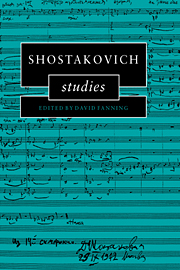Book contents
- Frontmatter
- Contents
- Acknowledgments
- 1 Introduction. Talking about eggs: musicology and Shostakovich
- 2 Public lies and unspeakable truth interpreting Shostakovich's Fifth Symphony
- 3 Form in Shostakovich's instrumental works
- 4 Russian theorists on modality in Shostakovich's music
- 5 The cycle of structure and the cycle of meaning: the Piano Trio in E minor, Op. 67
- 6 Leitmotif in Lady Macbeth
- 7 From Lady Macbeth to Katerina Shostakovich's versions and revisions
- 8 The Golden Age: the true story of the première
- 9 ‘And art made tongue-tied by authority’ Shostakovich's song-cycles
- 10 A debt repaid? Some observations on Shostakovich and his late-period recognition of Britten
- 11 Shostakovich and Schnittke: the erosion of symphonic syntax
- Index
2 - Public lies and unspeakable truth interpreting Shostakovich's Fifth Symphony
Published online by Cambridge University Press: 22 October 2009
- Frontmatter
- Contents
- Acknowledgments
- 1 Introduction. Talking about eggs: musicology and Shostakovich
- 2 Public lies and unspeakable truth interpreting Shostakovich's Fifth Symphony
- 3 Form in Shostakovich's instrumental works
- 4 Russian theorists on modality in Shostakovich's music
- 5 The cycle of structure and the cycle of meaning: the Piano Trio in E minor, Op. 67
- 6 Leitmotif in Lady Macbeth
- 7 From Lady Macbeth to Katerina Shostakovich's versions and revisions
- 8 The Golden Age: the true story of the première
- 9 ‘And art made tongue-tied by authority’ Shostakovich's song-cycles
- 10 A debt repaid? Some observations on Shostakovich and his late-period recognition of Britten
- 11 Shostakovich and Schnittke: the erosion of symphonic syntax
- Index
Summary
Now that the institutions that supported him, and that he served to his incalculable personal cost, have at last been discredited and dismantled, I find myself reflecting with urgency on Shostakovich, the musical figure from the Soviet past who has the most meaning for us today, wondering why he does so, and what that meaning might be.
Urgency has mounted in proportion to revulsion at the torrent of romantically revisionary, sentimental nonsense about the composer that has inundated both the Soviet (or post-Soviet), and the western musical press since the mid-1970s, but particularly since Gorbachov's proclamation of glasnost’ (airing-things-in-public) in the mid-1980s. Much of this literature has been motivated by an understandable but now pointless impulse to enjoy vicarious revenge. As long as the Soviet system and its institutions were alive and declaring themselves well, there was reason to do battle with them, reason to dwell on their hypocrisy, their criminality.
But enough of that. Poshlost’ – smug vulgarity, insipid pretension – has always lived and thrived in such accounts. Risking nothing, we excoriate the past to flatter ourselves. Our high moral dudgeon comes cheap. It is sterile. In fact it is nostalgic. We look back upon the Stalin period romantically, as a time of heroism. We flay the villains, as we define them, and enjoy an ersatz moral triumph. We not only pity the victims, as we define them, but envy them and wishfully project on to them our own idealised identities. Nor have we even given up our investment in personality cults, it seems; all we have done is install new worshipped personalities in place of the old.
- Type
- Chapter
- Information
- Shostakovich Studies , pp. 17 - 56Publisher: Cambridge University PressPrint publication year: 1995
- 2
- Cited by



